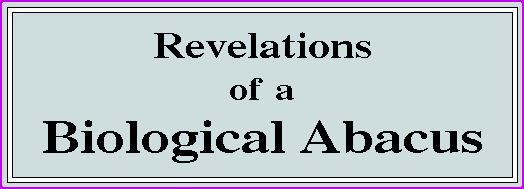

1. Preamble
Over the past few years, a number of world-class scientists have reported the discovery of numerical patterns in the universal genetic code. Thus, from France (Boulay), Russia (Gusev and Petroukhov), Kazakhstan (shCherbak), Serbia (Rakocevic) and Algeria (Negadi) - none of whom can be assumed to espouse the Judeo-Christian cause - we hear of the reality of what must be widely regarded as interesting news. However, such news, when interpreted in the light of what has already been established in the pages of this site as hard fact, threatens to lead to some uninvited and serious consequences - not least, in man's understanding of who and what he is.
This page focuses attention exclusively on the work of Vladimir shCherbak, as documented in his paper Arithmetic inside the universal genetic code*. However, before these significant findings can be offered to the eye of the general reader, it is necessary that certain relevant and generally accepted technicalities be briefly introduced and explained. Following this, all that remains is to allow the numbers to speak for themselves.
*Biosystems Vol.70, Issue 3, August 2003, pp187-209
2. Introduction
2.1 - The Amino Acids
Central to the chemical processes that occur to maintain the life of living organisms are the 20 amino acids (Table 1). They are the basic raw materials from which proteins are synthesised - these being substances that perform the essential structural and functional roles required in all living things. The amino acids, in turn, derive from the coded instructions contained in the organism's DNA (deoxyribonucleic acid) and RNA (ribonucleic acid). Each of these instructions (known as a codon) takes the form of an ordered string of 3 letters drawn from a genetic alphabet of just 4 characters, viz T, C, A and G (for DNA) and U, C, A and G (for RNA). Clearly, there exists only 64 unique arrangements of each of these (Table 2).
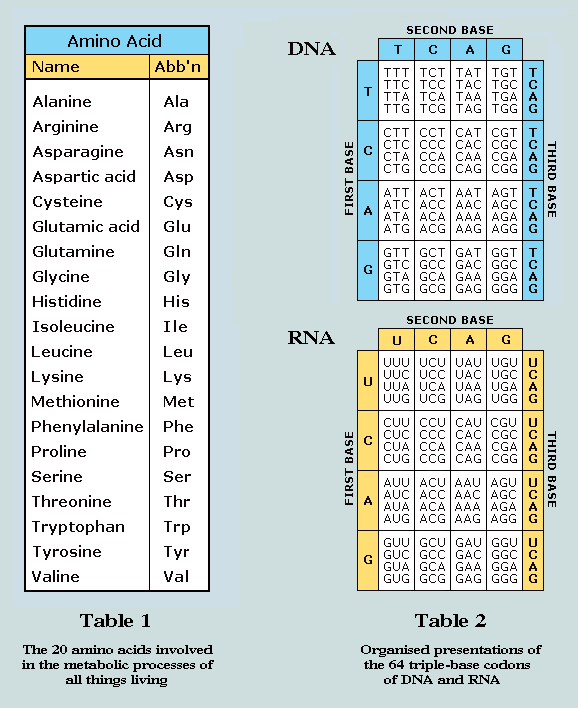
2.2 - Their Composition
The chemical elements involved in the structure of amino acids are tabulated below together with the numbers of protons and neutrons in their nuclei - the latter relating specifically to the most common isotope of each (Table 3). Of course, these elements, as they occur naturally, will be mixtures of isotopes, and it is important that we realise what the term 'common isotope' implies in this context (Table 4).
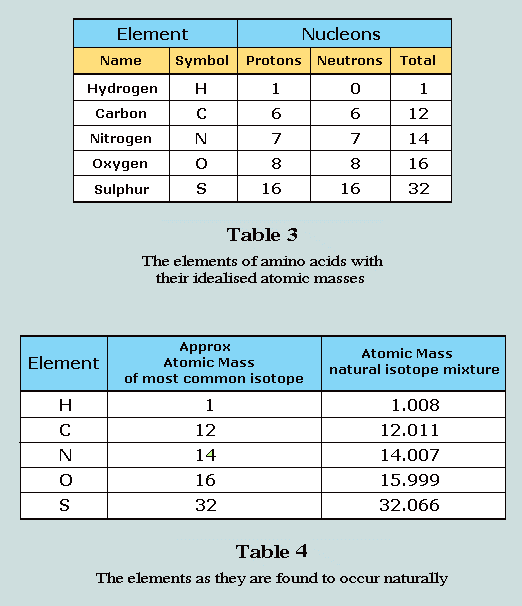
Clearly, the whole-number totals of nucleons recorded in Table 3 appear well-justified and, based upon these figures, the masses of the amino acid molecules may now be computed. However, before proceeding to do that, it is necessary that we consider an important structural feature of amino acids.
2.3 - Standard Block and Side Chain
It transpires that 19 of the amino acids comply with the generic formula:

Here, the lower component represents the so-called standard block - designated B. The variety in amino acid characteristics derives entirely from R - the unique side chain. The one exception to this general rule is Proline which has one less hydrogen bonded to the nitrogen of its standard block. Thus, applying the data of Table 3 to the elements of the standard block, we deduce the molecular masses to be
2 + 14 + 12 + 1 + 12 + 32 + 1 = 74 (for all amino acids excluding Proline), and 73 for Proline.
2.4 - The Portent
Let us immediately observe that these are interesting figures - and for the following reasons:
2.4.1 - The juxtaposition of 19, 74 (=2x37) and 73 will already be familiar to those acquainted with the pages of this site. Genesis 1:1 - as originally delivered in Hebrew - has the numerical value 2701, or 37x73; and the sum of its two final words, translated "and the earth", has the value 703, or 19x37. Further, both 2701 and 703 are coordinated triangular numbers. [Further details here]
2.4.2 - But the factors themselves are also related figurate numbers (Figure 1).
2.4.3 - 74 and 73 are each the penultimate term of a decimal sequence specified by the rule: S(r) - the rth term - is formed as the sum of the cubes of the digits of S(r-1) - the term immediately preceding. The ultimate term in respect of 74 is 407 (value of the 6th word of the Bible's first verse); and of 73, 370 (a cyclic rotation of 703 - the sum of words 6 and 7).* It should not pass unnoticed that 74, 407 and 370 are multiples of the unique trifigurate number 37; and that 73 is its decimal digit reflection. One further observation: the sum of 407 and 370 is 777, or 3x7x37.
* There are just 4 natural numbers, base 10, that equal the sum of the cubes of their respective digits. Along with 407 and 370, we have 371 (duration, in days, of the Noahic Flood) and 153 (the miraculous catch of fishes described in John 21:11). Remarkably, the last is the terminal value of any sequence (as described) that begins with a multiple of 3.
Since shCherbak's findings take us further along this route in which the prime number 37 dominates - but only when Proline is harmonised with the other 19 amino acids by transferring one hydrogen from R to B - in the circumstances, we believe this adjustment to be fully justified.
2.5 - The Molecular Masses - We are now in a position to evaluate the molecular masses (or nucleon counts) of the 20 amino acids. Here are the details:
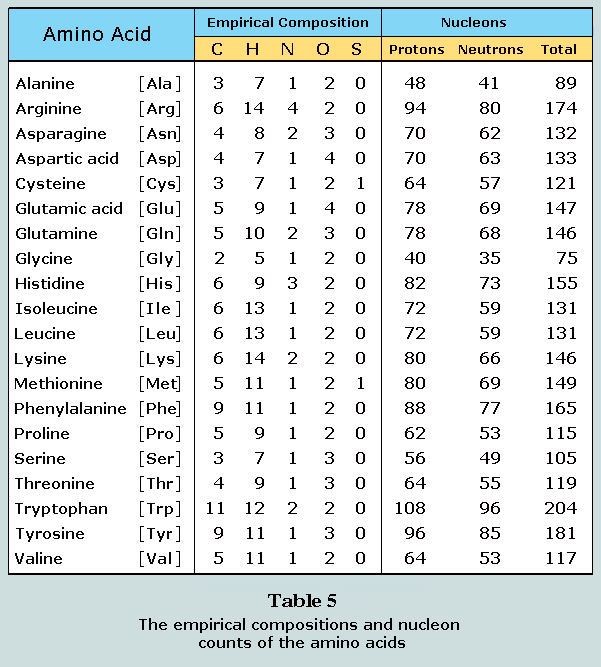
The separation of the B and R nucleons completes the picture, thus:
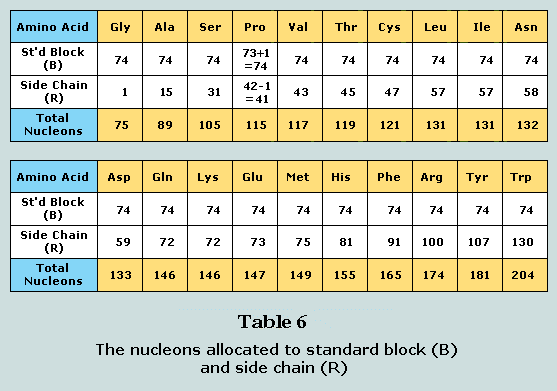
3. The Genetic Code
The genetic code can be expressed in terms of either DNA codons or RNA codons. Here are the details, as they may be found in any standard textbook on the subject:
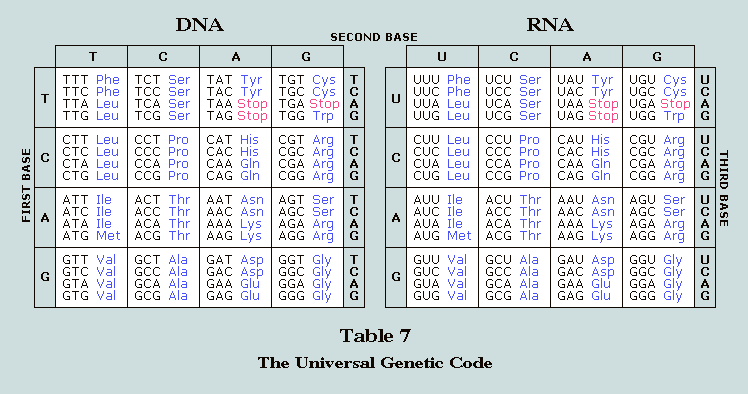
Observe that the only difference between these tables is that the thymidine (T) of DNA is replaced by the uridine (U) of RNA. Both incorporate 'Stop' instructions (which contribute nothing to the nucleon count); 'Start' is represented by the codons ATG and AUG, respectively, and is associated with the production of the amino acid Methionine. Our chief interest in these matters concerns the amino acids and their related codons. Consequently, the order in which the (codon)-(amino acid) relationships are presented may vary, at the discretion of those who work in this area. For reasons which will become obvious, shCherbak has chosen to use an RNA arrangement of his own.
4. shCherbak's Patterns
4.1 - The First Pattern - Here we see the 16 x 4-codon cells divided into two identical interlocking areas based on the observation that 8 (coloured orange) contain codons, all of which code for same amino acid, and the remainder (coloured blue) that do not.
The respective counts of nucleons for orange and blue areas are summarised below.
Observe that (a) yields the {R,B,(R+B} sequence {333,592,925}, or {9x37,16x37,25x37} in which the mulipliers of 37 are the squares associated with the classical pythagorean example. Of course, if all 4 codons producing the same amino acid are taken into account, these figures are quadrupled to produce {1332,2368,3700). Remarkably, these same figures are found together on the breastplate of the high priest (the details may be found here).
With respect to (b): we observe an even division of the total of nucleons between R and B. It is remarkable that there should be this exact balance between the contributions from standard blocks and side-chains, and that the balance should again be a multiple of 37.
4.2 - The Second Pattern - It has been established that the 64 RNA codons (the 3-letter codes) divide into 2 groups - those that begin with A or G, and those that begin with C or U. These groups are referred to as the Purines (coloured blue in the following table) and the Pyrimidines (coloured orange), respectively.
Observe that for the pyrimidines we again have a perfect balance between R and B. Both groups yield further multiples of 37.
4.3 - The Third Pattern - Here we examine two symmetrical divisions of the genetic code. The first, involving the amalgamation of the two central columns; the second, the amalgamation of the two central rows.
Division 1
Observe that for the blue group, the total number of nucleons in the radical (R) component of the amino acids is 789; and for the orange group, 654. The total represented in this category is therefore 1443, or 39x37.
Division 2
Here, we see the results of the earlier analysis duplicated. Once more a perfect symmetry is displayed - again involving multiples of 37.
4.4 - The Fourth Pattern - Here we identify and colour code those codons whose triplets include two identical letters. Thus, those codons highlighted in blue each incorporate a pair of Us; those in yellow, a pair of Gs... and so on.
- Observe the following:
- total nucleons in the R-component of paired A codons = 535
- ..................................................................... G codons = 464
- ........................................................ these amino acids = 999
- total nucleons in the B-component of paired A codons = 592
- ..................................................................... G codons = 666
- ........................................................ these amino acids = 1258
- total nucleons in the R-component of paired A codons = 547
- ..................................................................... G codons = 452
- ........................................................ these amino acids = 999
- total nucleons in the B-component of paired A codons = 666
- ..................................................................... G codons = 666
- ........................................................ these amino acids = 1332
The repunits 666 and 999 are a significant feature; again, each a multiple of 37 and directly involved in the Genesis 1:1 geometries.
4.5 - The Fifth Pattern - Switching here from an RNA to a DNA context, shCherbak focuses attention, (i) on the amino acids that arise from codons with 3 identical bases, viz TTT, AAA, GGG and CCC - appropriately, pairing T with A and G with C; and again, (ii) on all those that arise from codons with 3 unique bases. Here are the details:
Again, a perfect balance is observed, together with significant multiples of 37.
5. Conclusions
A reading of the Abstract to Vladimir shCherbak's paper Arithmetic inside the universal genetic code (it may be found here) reveals that he believes these numerical patterns - based on what he refers to as 'the criterion of divisibility by 037' - created themselves - along with 'a primordial version of the genetic code and genetic texts'. Further, he detects a 'base 10' number system underpinning all this; and even suggests that 'possibly a zero was invented and used by this mechanism'.
Such highly imaginative thinking is quickly brought to earth when it is realised that there are more points of contact between the genetic code, the Hebrew of the Bible's first verse, the breastplate of the High Priest (Ex.28:15-21) and the Name and Title of our Creator - the Lord Jesus Christ - than can fairly be accounted for by chance.
The facts presented on this site, when combined with those now revealed to us by shCherbak, constitute invincible evidence of the truth of the Judeo-Christian Scriptures, and of the Being and Sovereignty of their Divine Author.
Craig Paardekooper BSc
Vernon Jenkins MSc
2007-03-21